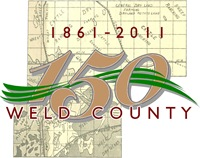Home
Courts
By County
Weld County
History of the Weld County Court House
| History of the Weld County Court House |
The Weld County Court House* has a rich history. For nearly 100 years it has stood as a cornerstone of the Greeley and Weld County communities. From its dark and murderous trials to its modern-day traffic court the Court House is a perpetual history in the making, a spectacle of remarkable architecture that has stood the test of time. Its historical background is complimented by its powerful and enticing architecture.
The structure, designed by W.N. Bowman, was built in two years. Bowman designed a number of notable buildings including the Jackson County Courthouse (Walden), Montrose County Courthouse (Montrose), Greeley Masonic Temple, the original Fort Collins High School, the University of Northern Colorado (UNC) President’s House in Greeley and Gunter Hall at UNC. Many of his structures are on the National Register, State Register or Denver Landmark Register.
The Colorado Office of Archaeology and Historic Preservation classifies the Court House as Beuax-Arts style. This one of several revival styles Bowman frequently employed in his buildings. This particular style of architecture was used extensively during the early 1900s for public buildings and other structures requiring imposing yet dignified facades.
The term Bowman used for the architecture in this building was Neo-Classical, a style that reflects the influence of the 16th-century Palladian architectural style and also was inspired by classical Greek and Roman ruins. As you approach the court house from any of its four sides you will notice the similarities it has with Greek and Roman buildings. The style of pillars holding up the roof in the design of scrolls at the top is a neo-classical concept. The exterior pillars are made of mammoth segments of Indiana limestone. The building’s foundation is primarily built with granite. All of the marble is rare Colorado white marble. This marble also was used for the Tomb of the Unknown Soldier and the Lincoln Memorial. The mine where the marble was qu
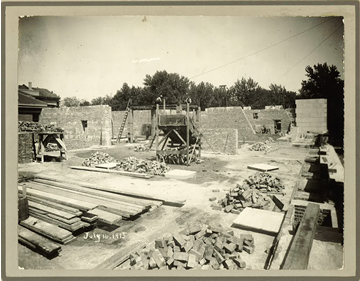 arried closed long ago. arried closed long ago. The Court House was built by general contractors Seerie & Varnum of Denver between 1915-1917during the time when Weld County was pronounced the second wealthiest county in the State of Colorado. The total cost of the court house was $414,302.05, which included new wood furniture. Weld County paid for the structure by raising taxes by $5.25 for every $1,000.00 of taxable property that person(s) owned. On July 4, 1917, the Court House was official dedicated and paid for in cash.
The ground floor once contained special vaults for storage of valuable county documents and books as well as the offices of the sheriff, coroner, and justice of the peace. There also was a large garage located in the southwest corner of the building that was used to store county-
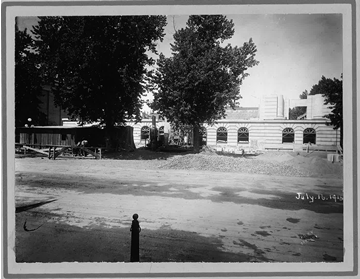 owned vehicles and vehicles belonging to county employees. Today, two courtrooms, the jury assembly area and two vaults fill this area. owned vehicles and vehicles belonging to county employees. Today, two courtrooms, the jury assembly area and two vaults fill this area. The second floor housed the offices of the county clerk, treasurer, assessor and county commissioners. Today, the floor contains four courtrooms and the family court facilitator’s office.
Offices of the county superintendent of schools and county surveyor were located on the third floor along with a county court and a district court courtroom, judges’ chambers, clerks’ offices, and separate facilities for witnesses. This area now houses two courtrooms and the administrative offices of the Nineteenth Judicial District courts.
The fourth floor was devoted entirely to the uses of the court and juries. The district attorney, court clerk, court reporter, and grand jury also were quartered here. Large sleeping rooms were provided for jurors who were sequestered during trials, one room for men and another for women. These rooms were furnished with single beds, washstands and dressing mirrors. Today the area contains three courtrooms, the court reporter’s office, law clerks’ offices, water and probate offices, and three of the previous sleeping rooms are now multi-use meeting and jury deliberation rooms.
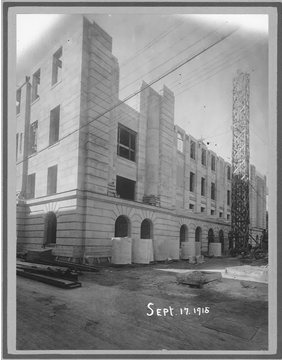 The Weld County Court House was home to county officials and the courts until the 1960s when the need for additional office space prompted the county to build new facilities. In the early 1960s, the county began moving its offices form the Court House to other buildings in the community. The first such move occurred in approximately 1964 when the treasurer and assessor’s offices and the motor vehicles department moved to the Elk’s Building that was located at the corner of 9th Street and 10th Avenue. That building was later razed to make room for the Centennial Complex. The Weld County Court House was home to county officials and the courts until the 1960s when the need for additional office space prompted the county to build new facilities. In the early 1960s, the county began moving its offices form the Court House to other buildings in the community. The first such move occurred in approximately 1964 when the treasurer and assessor’s offices and the motor vehicles department moved to the Elk’s Building that was located at the corner of 9th Street and 10th Avenue. That building was later razed to make room for the Centennial Complex. The early 1960s also witnessed the restoration of the ornate ceiling decorations that ha
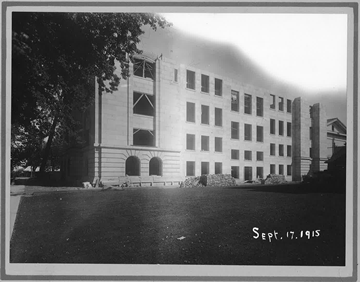 d been painted over in the 1930s by WPA, renovation of Division 1, and the addition of two the new courtrooms on the second floor. d been painted over in the 1930s by WPA, renovation of Division 1, and the addition of two the new courtrooms on the second floor. In the mid- to late-1970s, more courtrooms were added and the heating and ventilation system updated. In 1979, the old manually-operated elevator was replaced with a new electronic model. The last county office to move from the Court House was the Clerk and Recorder’s Office that moved into the newly constructed Centennial Center in 1976.
Courtroom scenes for the epic movie Centennial by James Michener were filmed in the original county courtroom on the third floor.
*The two-word version, Court House, is used here to reference the Weld Count Court House because on the front of the building was designated as such when it was built. with court employees. More information also is available in the Court House Architecture section.
|

